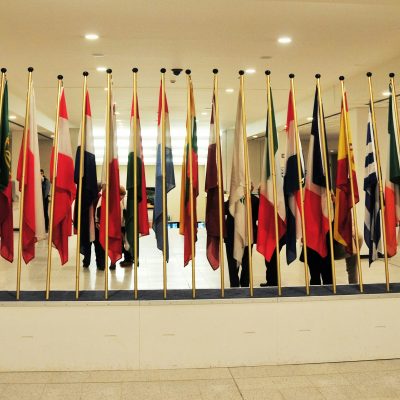The digital divide in armaments: an opportunity for Europe?

The emergence of information technology in modern weapons systems is nothing new. It is well known that the internet was invented by DARPA for military applications. The ability to share information in real time across networks has had a decisive influence on military strategy with the revolution in network-centric warfare that began in the 1990s. The proliferation and miniaturisation of sensors, distributed across platforms (aircraft, satellites, ships, armoured vehicles, drones, etc.) and combatants, is increasingly enhancing the operational power of this global information approach. However, the use of artificial intelligence in this context represents a real breakthrough that calls into question the logic that had previously governed the use of forces and the development of weapons systems.
In the current context, and without going into military strategies, this revolution has three major consequences for the European armament’s ecosystem:
1) We are now witnessing a clear shift in the allocation of resources dedicated to equipping the armed forces towards digital tools. It has been observed that the introduction of AI-powered devices can increase the performance of heavy equipment at a lower cost than increasing the production of such equipment. For less expensive equipment such as ammunition or drones, large-scale mass production remains essential, but to be effective, it must be accompanied by significant investment in software that enables them to be used efficiently. The performance of drone swarms on the Ukrainian battlefield today is as much a result of the intelligent control of their use as it is of their mass production (which itself benefits from digital technologies). The classic confrontation between sword and shield now applies to the digital field, with the ongoing struggle to counter the adversary’s means of interception and jamming, requiring constant updating of the software embedded in these unmanned platforms.
This development also makes it possible to exploit in a decisive manner two areas of capability whose priority has been confirmed by the war in Ukraine: robotisation and connectivity. The systematic use of drones – on land, in the air or at sea – is now an undisputed and achievable objective. Similarly, connectivity is becoming an essential feature of all weapons systems. These realities shed unique light on the complex negotiations surrounding the Future European Combat Air System (FCAS) project: its main challenge is not to build a next-generation piloted aircraft, but to create a coalition of different platforms linked together by a system capable of optimising their use. And the architecture of this system actually takes precedence over the definition of the aircraft… This is obviously a very marked break with traditional long-term developments aimed at replacing an existing aircraft with a new, more efficient version.
2) This reorientation of resources and objectives is accompanied by a shift in the centre of gravity of industrial armament activities towards digital technology:
– In the governmental sphere, we are seeing the establishment of dedicated financing structures alongside traditional procurement agencies[1].
– On the industrial side, new players such as Anduril in the United States and Helsing in Europe are emerging, reversing the traditional approach by offering solutions defined primarily by their software functionalities that leverage AI.
– Long-established companies in the IT and telecoms sectors are confidently entering the defence market, sometimes by creating new departments dedicated to this objective.
– Although no statistics are available yet, there is a growing number of skilled personnel and engineers leaving traditional companies in the sector to join one of these fast-growing new entrants.
From this perspective, the transformation undergone by the Ukrainian defence industry over the past three years, faced with the realities and urgencies of war, is instructive and, to a certain extent, serves as an example[2].
3) Finally, this digital shift in weapons systems is undermining army models built on a purely national basis. Through connectivity, it both imposes and enables the interoperability of equipment and a more even distribution of the missions assigned to each piece of equipment, making them more specialised. This development transcends borders as it concerns large systems providing major military capabilities such as intelligence, communications, air defence or land and air mobility (known as ‘strategic enablers’).
Paradoxically, it is also a powerful tool for overcoming insufficient standardisation and the diversity of equipment, which can now benefit from the same software prostheses. Put more simply, the growing digital component in equipment can enable its combined use, in a spirit of interoperability, even when it is of different origins. This is undoubtedly another explanation for the performance of the Ukrainian army, despite the diversity of weapons supplied to it by its supporters.
Together, these three breakthroughs are also changing the terms of transatlantic competition over the supply of arms to European countries, offering the American industry a workaround to the principle of European preference which progressively applies to European defence funding. The lead taken by the US, whether in AI data processing or cloud storage, enables it to offer immediate and competitive solutions to military users in Europe. The GAFAM companies, which have identified this opportunity, have developed defence offerings and are very active in Brussels in promoting them. This is a challenge for European strategic autonomy, for which control of data for defence purposes is a critical condition. It is also worth remembering that the F-35, which several European countries have purchased, is a connected aircraft whose use is conditioned by a highly intrusive digital environment specified by its manufacturer (giving it access to sensitive data and control of usage keys).
The inevitable and massive influx of digital technologies and AI into armaments is both a risk and an opportunity for European defence. It is a risk because it may lead to a technological gap and increase dependence on external players. It is an opportunity because it can have a powerful effect in bringing together, or even integrating, national defence systems by imposing a more targeted allocation of resources towards capabilities that are multinational in nature.
At a time when substantial European Union defence funding programmes are being set up and prepared[3], it would be logical for these resources to be divided into two vehicles : one to support, in the short term, the industrial investment essential to support Ukraine and to defend against the Russian threat, the other to finance and develop the innovative technological capabilities that are gradually becoming the backbone of our weapons systems. The establishment, if necessary outside the Community budget, of a defence fund backed by the borrowing capacity of the EU or its Member States and dedicated to the development of a sovereign military cloud and critical disruptive technologies for defence would meet this expectation.
[1] Such as the Digital Defence Agency (CND) or the Ministerial Agency for Artificial Intelligence in Defence (AMIAD), in France.
[2] See Blogpost: ‘War in Ukraine: a transformational impact on the European defence industry’, Jacques Delors Institute, May 2025
[3] See Blogpost ‘The uneasy equation of the future EU defence budget’, Jacques Delors Institute, July 2025




